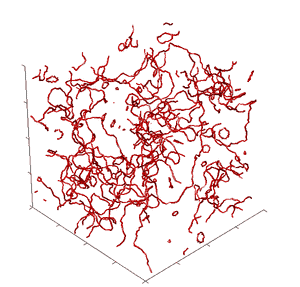The recent discovery of the Higgs boson has confirmed theories about the origin of mass and, with it, offered the potential to explain other scientific mysteries.
But, scientists are continually studying other, less-understood forces that may also shed light on matters not yet uncovered. Among these is quantum turbulence, writes Katepalli Sreenivasan, an NYU University Professor, in a special issue of Proceedings of the National Academy of Sciences.
Sreenivasan’s introductory analysis, written with issue co-editors Carlo Barenghi of Newcastle University and Ladislav Skrbek of Prague’s Charles University, examines the direction and promise of this phenomenon.
Quantum turbulence is the chaotic motion—at very high rates—of fluids that exist at temperatures close to zero.
Observers as far back as Leonardo da Vinci have studied turbulence—a complex state of fluid motion. The Renaissance artist observed that water falling into a pond creates eddies of motion, thus realizing that the motion of water shaped the landscape.
Today, scientists study much bigger ponds—the universe and beyond—but remain focused on this phenomenon’s basic principles.
This is because of its fundamental significance in daily occurrences—for instance, the efficiency of jet engines depends on turbulence—as well as its impact on developments far beyond our observation, such as the generation of galactic magnetic fields.
However, many of its workings continue to elude comprehension.
“Turbulence still provides physicists, applied mathematicians, and engineers with a continuing challenge,” the authors write.
The PNAS issue focuses on a special form of turbulence, quantum turbulence, which appears in quantum fluids. These fluids differ from ordinary fluids in some fundamental ways—in addition to their vitality at near-zero temperatures. One, they can flow freely because they have no viscosity—or resistance hindering flow. And, two, their rotation is limited to vortex lines—in stark contrast to eddies in ordinary fluids, which vary in size, shape, and strength.
The introductory article co-authored by Sreenivasan, a professor in NYU’s Courant Institute of Mathematical Sciences and NYU’s Department of Physics as well as the Eugene Kleiner Professor at the Polytechnic School of Engineering, outlines the basic properties of quantum turbulence and considers the differences between quantum and classical turbulence.
“Our aim is to link together the articles of this special issue and to provide a perspective of the future development of a subject that contains aspects of fluid mechanics, atomic physics, condensed matter, and low-temperature physics,” the authors write. “Further experimental studies of quantum turbulence, probing physical conditions not known to Nature at temperatures many orders of magnitude lower, may uncover phenomena not yet known to physics.”


The idea of “a new key to unlocking the mysteries of physics, Quantum Turbulence”, the new key being quantum turbulence, is being used to understand even stranger phenomena than itself, is fascinating. The more we know about superfluids and superconductors, the easier it will be for us to use them in everyday life and to not only improve our quality of life but decrease our strain on the natural resources.
The uncovering of new properties of known elements shows that science is still evolving and that we haven’t discovered everything yet as these properties where discovered at very low temperatures and in very high pressures environments (which are unnatural in earth’s environment). Furthermore once these properties have been discovered and scientists can pinpoint at which low temperatures and high pressures specific elements can go into their superforms; they can then create superfluids and superconductors that can exist in their superforms in a normal earth environment, thus making it accessible for humans to use and thus with the superfluids and superconductors new properties, will help us decrease our unnecessary waste of unrenewable resources.